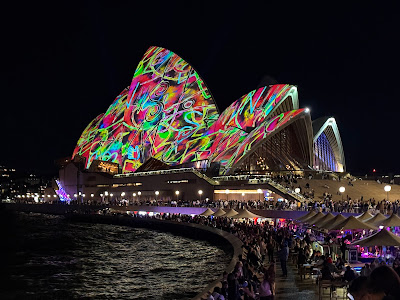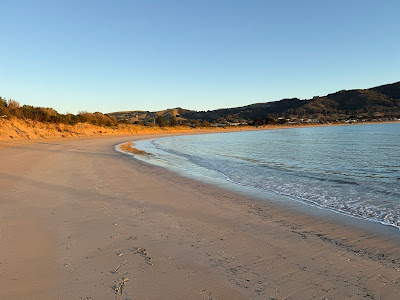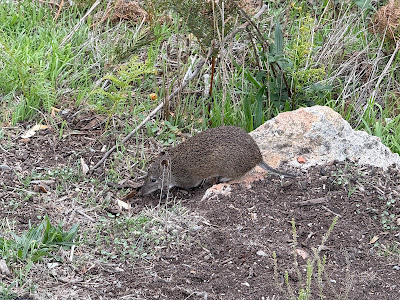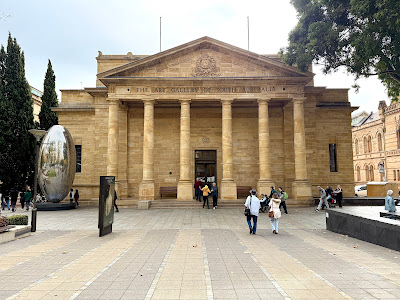 |
| Early Morning View from Hotel, Adelaide |
Sunday May 25 was our last day in Adelaide. I got up early for run around the neighborhood near the hotel. There was a nice park, Rymil Park, and many nice homes in this gentrified and obviously quite expensive neighborhood. There was a beautiful sunrise view from the upper level of our hotel.
 |
| The Ghan |
We took a Uber to the Parklands Terminal out in a suburb of Keswick. At the terminal we joined our other passengers for the epic train trip through the center of Australia. The train is called the Ghan, after the Afghan camel handlers that came to Central Australia in the 1800’s. There was a check in procedure like at the airport and we were given our carriage and cabin allocations. The train was impressively long - 39 carriages, 2 engines, almost a kilometer long.
 |
| Our Comfortable Compartment |
After drinks and snacks we were allowed to board the train around 12:00 pm. Our compartment was quite nice - two bunk beds that fold away during the day to form a nice couch, a toilet and shower combination, a bit of storage and a table by the window.
After we started moving and rolled out of Adelaide we went to the lounge car and enjoyed the view of the landscape rolling by - the appreciation of the view enhanced by the fine coffee and the McClaren Vale Shiraz wine.
 |
| North of Adelaide |
As we left Adelaide there were many nurseries and greenhouses presumably supplying produce to the major city of Adelaide. As we got further out this changed to agricultural land, primarily growing wheat I believe.
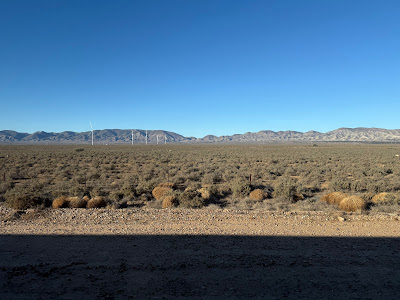 |
| Flinders Range |
Further on we could see the Flinders Range mountains over to the east.
We went to the dining car for our lunch around 1:30. A very nice light lunch and of course it was accompanied by the finest of wines. This was going to be a difficult trip if we kept drinking wine, so we learned how to ask for a half glass of wine, or a low tide glass as they say there. We shared a table with a couple of Australian ladies, Miranda and Jackie who were both delightful company at the table.
 |
| Wind Power Generation North of Port Augusta |
We passed by Port Augusta, a fairly large and industrial town and then we were back out in the bush. There was a considerable amount of wind power being generated.
 |
| Sunset from the Ghan |
Somewhere along the way we passed nearby Woomera, the British and Australian rocket testing facility during the Cold War. Woomera was always being mentioned in my youth in England as progress was being made on various rocket systems. Alas it must either of been dark or I wasn’t paying attention but I didn’t see any evidence of the Woomera base.
Before long it was 7:30 and time for dinner and more wine. Another beautiful meal - I tried the Kangaroo loin and found it to be very nice and tender - very similarly to a beef steak.
We retired to our compartment where the bunk beds had been prepared and our nightcap drinks of Baileys Irish Cream had been delivered. I had the top bunk and Diana the lower one. It was all very comfortable. The gentle rocking of the train made it quite easy to fall asleep.
Sometime in the night we passed nearby Coober Peedy, the opal mining area. Coober Peedy is the town where all the residences are underground to shelter from the heat. Coober Peedy in the local Aboriginal language means “man in hole”.
 |
| Sunrise stop in Marla |
At 6:30 we were awoken and the train stopped and we all got off to experience the sun rise over the outback. It was quite chilly. We were in the settlement of Marla, which is not much more than a siding on the railway. The crew on the train had built wood fires and we warmed ourselves by them while drinking coffee and eating bacon and egg rolls.
After a beautiful sunrise we were back on the train and on our way again. As far as you could see the land was flat red dirt low scrub.
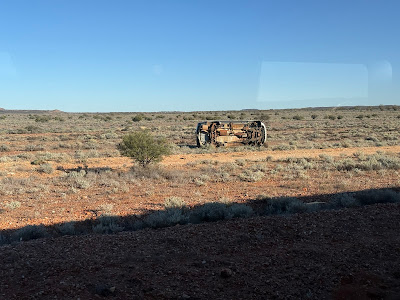 |
| Abandoned Car by the Road |
There was a dirt road next to the railway. Every now and again we passed the remains of a car. Usually upturned or on its side and everything useful (tires, wheels, etc) stripped of them.
 |
| Near Alice Springs |
We rolled along through fairly monotonous red landscape. Some areas had charred remains of trees from past fires. We did see one cow, we passed a couple of water holes with hoof prints around them so there is life somewhere. We even passed one car moving along the road but that was the only sign of civilization.
We then gathered in the restaurant car for lunch. We sat with a couple of Australian ladies, Rosalyn and Caroline. They were most interesting, one an artist the other an academic lawyer. They sold us on visiting Perth and Western Australia. Sadly that will have to be another trip.
Around 1:20 we arrived into Alice Springs. It is the biggest town in the “Red Center” but it is not really that big. We were met by a taxi driver who ferried us to our hotel. We were too early to check in so we walked down the road. As we were passing an adjacent hotel we noticed our friends, Miranda and Jackie standing outside. They were heading for an art gallery, so we tagged along.
 |
| The Archibald Prize Winner |
 |
| My favorite from the Archibald Prize Collection |
The Araluen Gallery was hosting an exhibition of portraits that is held each year in Australia for the best portrait. The artist is awarded the Archibald Prize which in 2025 was $100,000 Australian. The exhibition was actually very good. One of the best exhibitions I have ever seen.
We bade farewell to Miranda and Jackie and set off walking into the center of town. We walked down streets lined with walled and fenced homes - not a good sign. Everyone was securing their property. It was of course quite warm but not unbearable. What was interesting was the number of flies. Small black flies, they don’t bite but they are a nuisance. The first thing we did in town was to buy fly nets. Readily available and not expensive.
We went into a few Aboriginal Art galleries, of which there are many and then we went into a Woolworths store to buy food for dinner that evening and breakfast the next morning.
The next day we were picked up at 7:00 for our road trip to Uluru (Ayer’s Rock). The tour company, Emu Run, had an entire bus for our trip to Uluru but only about a dozen passengers so we had plenty of space. The driver and guide was a young English guy from Skipton in Yorkshire, quite the entertaining guide.
It was a 4 hour drive to Uluru with fairly monotonous red dirt scrub land. The driver was good at keeping us entertained with stories - the Pine Gap US monitoring station, the Cannonball Run memorial to the 4 people killed in the last race, the Flying Doctor Service, Road Trains of 4 or even 5 trailers, Harold Lassiter’s attempts to find gold in the outback and his eventual death trying to find it, John McDouall Stuart’s many attempts to cross the Australian continent from north to south and his eventual success, the cattle station that is as big as Belgium. All very entertaining.
 |
| Road Train |
We stopped for a break and coffee at the Erldunda Roadhouse, allegedly in the center of the center of Australia. There were emus wandering around at the Roadhouse and a 4 trailer road train in the gas station.
 |
| Feral Camel |
We came across a camel crossing the road ahead of us. Just the one camel casually walking across the road. The driver had told us the story of Harry the camel, one of the first camels shipped to Australia and the only one to survive the journey. Later larger quantities were shipped and they survived better. When camels were not needed for transportation any more they were let free to roam and now there are some 1,500,000 feral camels. Because only the fittest camels survived the journey to Australia their descendants are of such good quality that they are now shipped back to the Middle East
 |
| Mt Connor |
Just before reaching Uluru we stopped and climbed up a huge sand dune to look down on a white salt lake. Then in the distance there was a smaller version of Uluru, Mt Connor.
We arrived in the town of Yulara, the purpose built site for hotels and shops catering to the needs of tourists visiting Uluru. It was sad to hear that all the hotels and concessions in Yulara were operated by an American company.
We had lunch and stretched our legs before getting back on the bus to tour around Uluru itself.
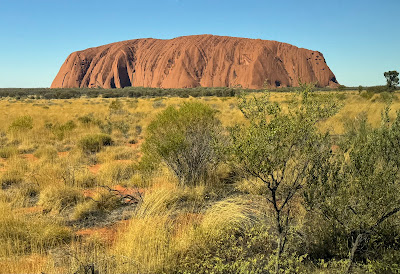 |
| Uluru |
It is truly a dramatic rock formation that looms above you for 1,000 ft as you peer up from its base. Its circumference is 6 miles. We visited certain sites around the base of the rock and did some short hikes - small caves, some rock paintings, a water hole. The guide tried to explain various Aboriginal myths about different parts of the rock. Certain shapes on the rock represented different items (snakes, people, animals), each having a particular significance or telling a particular story. To be honest I couldn’t follow the stories very well.
 |
| Just a few flies |
The flies were everywhere and for most of us, except some of the locals, it was impossible to bear them without a fly net over your head. Everyone said that they were worse than normal and put it down to a recent rainfall that gave them a new breeding season.
There were areas on one side of the rock that we were not allowed to photograph. These parts of the rock are particularly sacred to the aboriginal tribes of the area so restrictions apply.
 |
We could also see the pathway up the side of the rock where up to 2019 you could ascend to the top. Since that time it has been off limits to tourists.
We left the rock and drove over to a cultural center that tried to explain some of the aboriginal myths. There were also the obligatory gift shops where you could buy quite expensive aboriginal art and artifacts.
 |
| Uluru at Sunset |
Later in the afternoon we drove some distance away to get a nice view of the entire rock. This is where we were able to watch the sun set and observe the many different hues of the rock as the light diminished. Viewing the rock at sunset is quite the thing to do. There were many buses and vans and cars waiting for just the right moment to capture that amazing photograph.
 |
| Kata Tjuṯa |
Off in the distance we could see the other rock formation in the area - Kata Tjuṯa. This is a series of domed rocks also known as the Olgas.
We were then provided with a barbecue dinner before boarding our bus for the long 4 hour drive back to Alice Springs. We stopped at the Curtin Springs Roadhouse for a bathroom break on the way back - the toilets were labeled Blokes and Sheilas. The road trip back was uneventful but we didn’t arrive until midnight.
The next morning we were met at 7:30 for our next tour, a trip around the West McDonnell Range. Our guide was Ben and we were the only two people on the tour so we had a lot of freedom to move at whatever pace we wanted.
 |
| Simpson’s Gap |
Our first stop was Simpson’s Gap, a narrow gap in the pre-Cambrian quartzites of the West McDonnell Range. There is a permanent water hole in the bottom of the gap. The flies were there of course so we had our nets that aside it was quite a beautiful site.
Leaving the Simpson Gap we saw a Euro. We had not heard of a Euro before, but it is the smallest of the kangaroo family.
 |
| Standley Chasm |
Our next stop was Standley Chasm or Angkerle Atwatye in the aboriginal language. This is a narrow canyon also in the West McDonnell Range with towering walls on either side of the narrow path. We walked up the path until the walls of the canyon came together in a waterhole preventing our onward passage with dry feet. There were lots of Red Gum trees and the white barked Ghost Eucalyptus trees.
Our guide told us that we could hear the water flowing below the trees or was it within the tree trunk. We placed our ears next to the tree and we certainly could hear something like flowing water.
On the road out of Standley Chasm we were stopped by a herd of wild horses (Brumbies). Unlike some of the wild horses in Nevada, these horses looked very fit and healthy.
 |
| Ellery Big Hole |
Our next stop was the Ellery Big Hole, a permanent water hole.
 |
| Ochre Pits |
From the Big Hole we drove on to a group of Ochre Pits, used by the Aborigines for decorative paint - orange, white and brown - a fairly limited palette.
 |
| Ormiston Gorge |
Next stop was Ormiston Gorge where we had lunch in a small cafe before we set off up the hill to enjoy the views of the river and water hole below. This was a nice hike, if a little strenuous on the way up. The view down into the narrow canyon below was quite spectacular.
 |
| Ormiston Gorge |
Back down at the parking lot we walked out along the river for some distance. The calm water of the water hole provided a perfect reflection of the trees and rocks as the afternoon sun got lower in the sky. There was a nice heron fishing in the pond and a group of cormorants were sunning themselves on the water bank, We walked through the undergrowth to get back on the path and we must have scared a snake from the area. As we reached the trail we saw a fairly large brown snake sliding out of the undergrowth and across the trail. Our guide said it was likely poisonous, likely a Taipan.
Back to the bus and then we set off back to Alice after seeing a great sample of the beauty of the West MacDonnell range.
Back at the hotel we cleaned up and then walked to the golf course behind the hotel where there was a restaurant. Beer and pizza for dinner.
The next morning we checked out of our hotel and stored our bags there and went off to explore Alice Springs. This was our last day in Alice.
 |
| Black Footed Wallaby, Olive Pink Botanic Garden |
We started by walking down the now dry Todd River to the Olive Pink Botanic Gardens. The Botanic Gardens feature native plants of the Central Australian area. It was initiated by a local anthropologist and indigenous rights campaigner Olive Pink. It is a haven of vegetation in what is a very dry part of the world. We walked up the trail to the top of the hill overlooking Alice. There were several black footed Wallabies around the area - beautiful little creatures.
 |
| Aboriginal Galleries everywhere in Alice Springs |
We walked further on into town (with our fly nets on of course). In town we did a little shopping for aboriginal art - a nice painting that we will get framed back in the US from the Papunya Tula Artists Collective.
 |
| Traeger’s Pedal Powered Radio |
We went inside the John Flynn’s House, the first hospital in Alice Springs. Not a very big hospital, it couldn’t have handled more than 2 or 3 patients. The museum had examples of the early pedal powered radios. These pedal powered radios were invented by Australian Alfred Traeger and they played an important role in communications from remote stations in the outback. They subsequently spread to other remote regions of the globe.
 |
| Sculpture outside Museum of Central Australia |
We next made a trek out to the Museum of Central Australia. Quite a way from the center of town in the heat and flies too. Sadly the museum was closed. Diana made up for it by going next door to the previously visited Araluen Gallery and buying yet another pair of ear rings from the gift shop.
 |
| The Ghan’s Two Engines |
We took a taxi to the hotel for our bags and then caught the bus from the next door hotel Doubletree to the station for our train. The Ghan travels twice a week in each direction from Adelaide to Darwin with a stop in Alice. We broke our journey in Alice but many just carry on straight through - that is a shame as Alice and Uluru are quite unique. At the station we had to wait quite a while for our train to come in. We were finally on the way by 6:00 pm. A new carriage, slightly older, but just as good.
Shortly after departing Alice Springs we had dinner - Crocodile Dumplings and Barimundi. We shared a table with an Australian couple whose name escapes me. They owned an athletic shoe shop and they were serious travelers. On the whole we met the most interesting people on the Ghan.
After a good nights sleep in our compartment we arose for early morning breakfast. We sat with an American couple, Johnathan and Penny, an Orthopedic Surgeon and his wife, from Mammoth, California. We hadn’t met many Americans on this trip, they are not usually good travelers. Johnathan and Penny were avid bridge players. They told us of their investment success in buying US Post Offices. Who knew?
The train stopped in the town of Katherine mid morning and we were taken by bus to Nitmiluk. In Katherine we learned that it once was a major meat exporter and it had a large meat processing plant. Nowadays, it is more common to export live cattle so the plant has closed down. We also learned that Katherine was bombed during the World War II. I didn’t realize that the war impacted that part of the country.
 |
| Katherine River near Nitmiluk |
 |
| Rock Paintings near Nitmiluk |
In Nitmiluk we took a boat ride down the river to view the canyon and visit a site where there were some rock paintings. The canyon was quite spectacular, but that’s not what we could say about the rock paintings. They were interesting but not that spectacular. However, the nature of one of the rock art paintings suggested that it might be one of the earliest examples of perspective drawing.
 |
| A Fresh Water Crocodile - a Freshie |
We learned that if any salt water crocodiles got into this part of the river they are trapped and removed. Salties prey on other animals and are also a danger to people so they do not want them to become established in the river where people often kayak. They place small red floats in the river to detect salties. Crocodiles are inquisitive, they bight the floats and then move on. The salties leave big teeth marks, the freshies leave smaller teeth marks. So long as all they see are small teeth then everyone is happy. We did see a freshwater crocodile, lazily lounging on a rock.
The boat returned us to the Nitmiluk boat dock where we went ashore and had lunch. A communal lunch with everyone from the train served in one big outdoor verandah. Both crocodile and kangaroo were on the menu. Kangaroo is quite nice but the crocodile tastes a bit like chicken and is not my cup of tea.
We boarded the bus back to Katherine and boarded the train one last time. We had about 300 km to go from Katherine to Darwin. Most of the way it was dry scrub and grass land. I had expected it to be more tropical.
 |
| Sunset on arrival in Darwin |
We had a nice light dinner with Diana, a Welsh lady, and Jack her Dutch husband. We arrived in Darwin at about 7:00 pm and we all disembarked and boarded buses for different hotels in the area. We were dropped off at the Hilton in the city center, a short walk from our hotel, the Darwin City Hotel.
 |
| Central Darwin |
The next morning we went for a walk around the city center. It is not a huge city. We had coffee and a scone outside in the Smith Street pedestrian mall then walked to the esplanade and the lagoon. The lagoon is a man made salt water pool. It is not wise to swim in the ocean in Darwin, the beaches aren’t great and there are salt water crocodiles and sharks in the sea so it is a bit dangerous. There is a new cruise ship dock so they are allowing large passenger boats in the harbor.
 |
| Beach in Darwin |
Next we took an Uber to the Museum of the Northern Territory. The museum was a little disappointing, it had a few stuffed animals and the like but not much in the way of art or historical exhibits. I watched a documentary about the 1974 cyclone, Cyclone Tracy, This caused great havoc and the loss of 66 lives. It just about flattened the entire town and many thought it would never recover.
Diana’s cousin Mira and her daughter Bojana who live in Darwin met us outside the museum and took us for lunch at the Parap market. We were had a great meal of Laksa - an oriental spicy noodle soup and Mango Lassi - a yoghurt drink. We wondered around the market for a while and Diana managed to secure yet another pair of earrings. We then drove over to Bo’s flat to cool down.
 |
| Sunset at the Yacht Club, Darwin |
In the evening Mira and Bo took us to the Yacht Club to dine and watch the sun go down. It was a lovely evening looking out over what is the Beagle Gulf and further out to the Timor Sea. We had that Australian classic - Baramundi and chips.
 |
| War Memorial Toilet, Central Darwin |
Next morning I was up a little early so I went for a run around the city. Out to the Esplanade and around the government buildings. As is common in Australia there were memorials to the war dead but here in Darwin things were a little closer to home as Darwin was bombed by the Japanese in WWII. I didn’t realize that Japan was intent on invading Australia.
 |
| Darwin Murals |
Of course, as is the norm these days with any decent sized city there were some nice murals in Darwin,
Back at the hotel we checked out and Mira picked us up and we went to pick up Bo, who was finishing her work shift at the hospital. We all then went out for breakfast near Bo’s apartment. A great breakfast of pancakes fruit and ice cream with the usual great coffee. After that they drove us to the airport for our flight back to Sydney.
It was a Quantas flight, a step above our cheap Jetstar flights. We landed in Sydney around 6:00 and, even though we were leaving for the US the next morning, we decided to make one last trip into the city to view the bridge and the opera house. We had a room at the same hotel as before, the Sir Stamford, near Circular Quay.
Imagine our surprise when we got off the subway at Circular Quay when we found the whole area lit up with lights. It was a festival known as Vivid Sydney. Every building around Circular Quay was lit up, even the Opera House and the Bridge and the lighting was quite amazing - projections of all colors and patterns and stories with music and people everywhere. It was stunning. There was even a modest fireworks display by the Opera House.
A fitting end to a wonderful vacation in Australia. Certainly one of our best ever vacations. We stayed walking around for 2 or 3 hours until the crowds started to dissipate. Then it was back to the hotel for one last night in Oz.
 |
| Departing Sydney |
The next day, a Monday, we caught the subway out to the airport. It was National Sorry Day, when the Australians apologize for their harsh policies towards their Aboriginal population. Free trains and subway rides on National Sorry Day so we didn’t have to pay.
We had a shortish 8 hour flight to Hong Kong, a couple of hours in Hong Kong Airport and a 13 hour flight to San Francisco. In SFO, Mr Trump allowed us back in the country, and we had smooth connections between BART and Amtrak and the Uber to our house.
We can’t wait to do it again - Western Australia maybe, New Zealand certainly.

